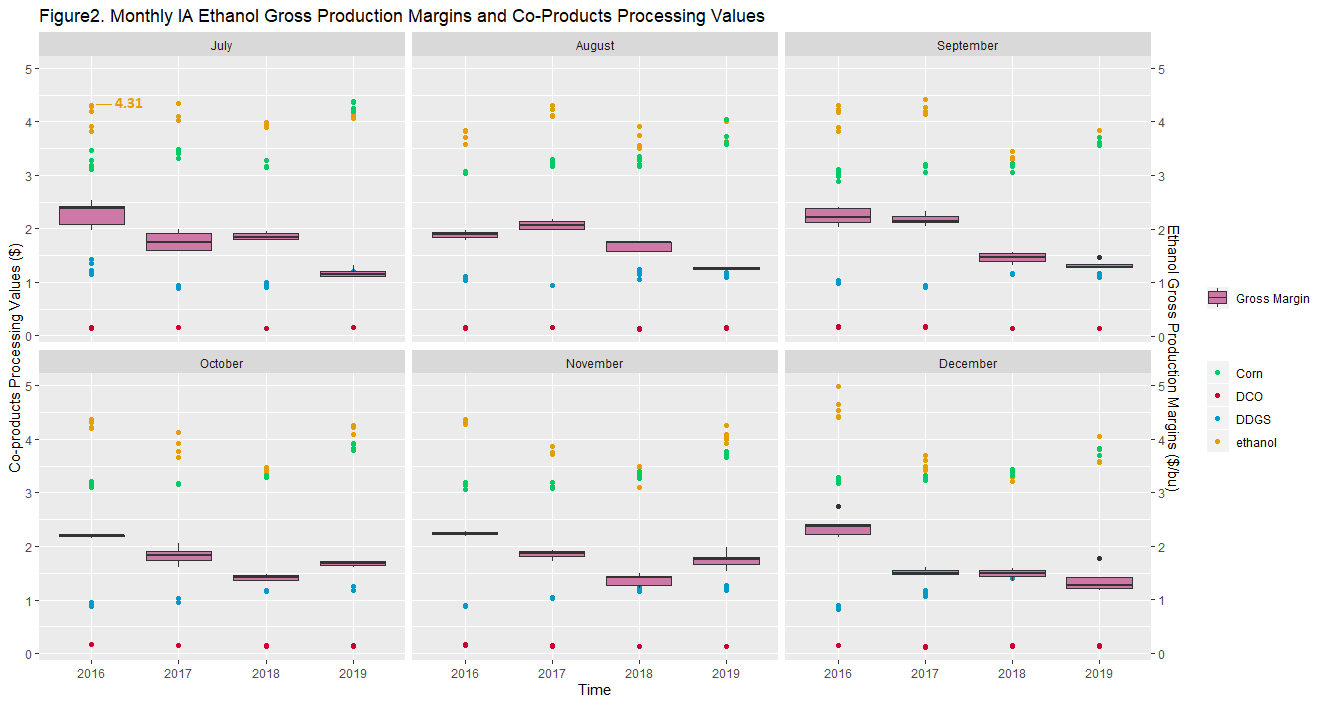We had unnormal weather events throughout 2019 April and May in the Midwest and Iowa that led to very significant delays in the corn planting process, which was one of the main reasons that the July corn future prices changed abnormally. In our previous blog, we discussed how the ethanol gross production margin (GPM) behaved in the first half of 2019. In this article, we will focus on the behavior of GPM in the second half of 2019.
The gross production margin, in the ethanol industry, commonly represents the difference between the combined sales values of ethanol, distiller’s dried grains (DDGS) and distillers corn oil (DCO), and the price of corn. All data came from USDA-AMS weekly report, Iowa ethanol corn and co-products processing values. The latest data was updated on December 27, 2019. GPM calculation shows the calculated relationship between values of ethanol and ethanol co-products and the cost of corn in ethanol production.
Figure 1 shows the monthly average Iowa ethanol GPM of the year 2018 and 2019, in solid line and dashed line, respectively. Also, it shows the three-year average (2016 to 2018) Iowa ethanol GPM for each month. Since July 2018, the monthly GPMs have been below three-year average values. From May 2019, the margins were getting smaller due to higher corn prices, as we mentioned in the previous blog. But after October 2019, the margins returned back to the three-year average level, around $1.70 per bushel of corn, then it dropped back to $1.37 per bushel. This was primarily due to the changing ethanol price.
The GPM was $1.67 per bushel of corn in October 2019, compared to $1.42 a year ago. The values of ethanol, DDGS, and DCO in October 2019 were $4.2, $1.19, and $0.14, respectively. While those co-products’ values in October 2018 were $3.42, $1.17, and $0.14, respectively. Both ethanol and DDGS value are higher in 2019 than in 2018. And the ethanol value increased 23% from October 2018 to October 2019. While, the values of ethanol, DDGS, and DCO in December 2019 were $3.69, $1.30, and $0.14, respectively. The GPM dropped to $1.37 per bushel of corn in December 2019, compared to $1.75 a month ago.

We noticed the key factor that affected the GPM was corn price during 2016 Summertime to 2019 Summertime from the previous blog. This time, we are focusing on the second half year period (July to December), from 2016 to 2019. In Figure 2, the scatter points represent the weekly sales values (raw data from AMS weekly report) for corn, ethanol, DDGS, and DCO using green, yellow, blue, and red color, respectively. For instance, in the July plot, the top yellow point corresponds to the ethanol sale value (gross value of ethanol sold per bushel of corn), $4.31, at the Week#28, 2016. The boxplots in pink color, represent the range of weekly IA ethanol GPMs. Still using the July plot as an example, the first box shows that the GPMs in July 2016 were in the range from $1.98/bu to $2.52/bu.
Applied ANOVA and Tukey-HSD test on the study period, i.e., July to December in 2016 to 2019, we found that the GPM numbers in 2019 are at a significantly low level compared to the previous three years, except for October and November.

Applying the Pearson correlation test, we found that within the study period, corn price has had strong significant negative effect in the month of July, and the effect becomes weaker but still significant as the time moved forward. In October, corn price doesn’t have any significant effect. The sale value of DDGS has had significant negative effect on GPM for all months within the study period, except for July. The sale value of DCO has no effect on GPM in the month of July and August, but after September, it has had significant positive effect. The sale value of ethanol has had significant positive effect on GPM, after the month of August, and it becomes stronger as time moved forward.
In summary, corn price was the dominant variable in the months of July and August, which was a significant, negative effect. The sale value of ethanol has become a leading factor after the month of September, during this study period.

